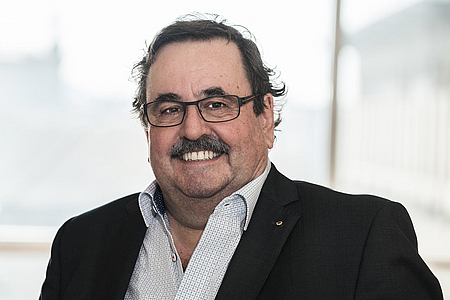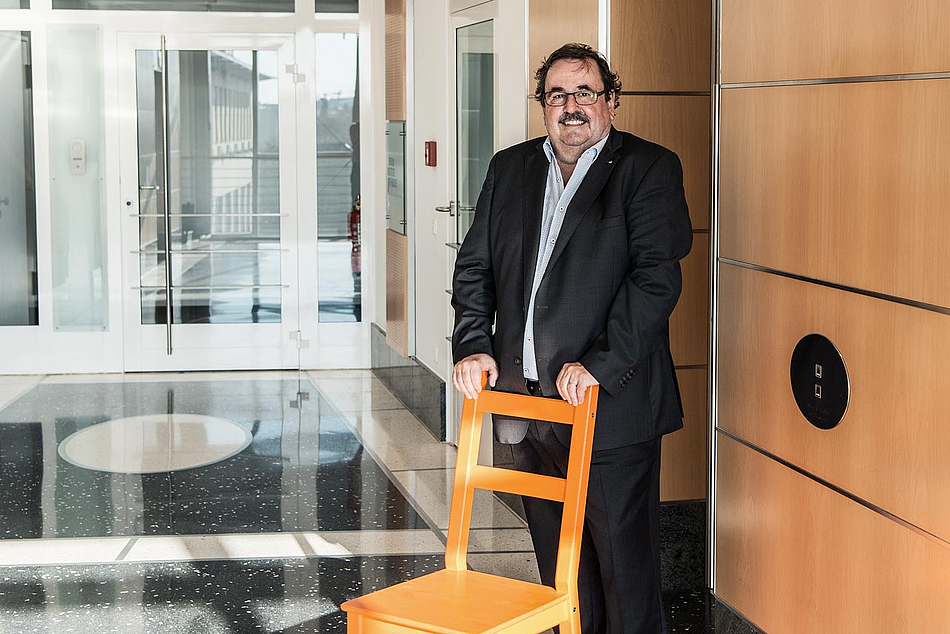From mechanic and photographer to entrepreneur and innovation driver
As BIH Visiting Professor, Robert Frigg wants to support young project teams in developing their ideas for innovative medical products. In an interview, he told us why he wants to do this and how he, a former mechanic, became an inventor of medical products.
Professor Frigg, you originally trained as a mechanic. Were you already screwing bones together back then?
Initially, I wanted to become a helicopter pilot. Anyone who trained as a mechanic had the option to retrain as an aircraft mechanic, but in the end I was unfortunately unable to enter the training program after all. As I liked taking photographs, I simply turned my hobby into my job and took up a post as a photographer at the AO Foundation in Davos, one of the world’s leading foundations in the field of bone research.
What did you photograph there?
Biomechanical examinations, histology, scanning electron microscopy, animal experiments – lots of things.
How did you get into developing medical products?
One day, the head of the laboratory came to me and asked whether I could stand in for the in-house mechanic. I had a certain talent for detecting mechanical problems. I also observed operations and quickly saw what wasn’t going well. I then wanted to solve those problems, which was how I developed the first ideas for new implants.
What exactly brings you here to Berlin?
My prime objective is to translate research results into clinical application. Medical technology has changed. In the past, the innovations came from the clinic and the industry provided the investment and the know-how to bring the products to the patient. Due to increased regulation, companies have become more cautious – they don’t want to take risks any more. The driving force behind innovation used to be the industry, today the inventors themselves have to deliver a lot in advance. This involves processes that the university clinics are generally unable to carry out. How many academics have time for that? We therefore have to make an idea attractive for the industry and that’s what I consider my role. As a BIH Visiting Professor, I support young teams in Berlin in defining and further developing their projects.
How exactly does your collaboration with the clinicians work?
To me, the most important thing is to get to the bottom of the clinical problem. When you’re standing at the operating table, you try to solve the problem by means of the methods that are already available. In the team, we think about how things could be done differently. This often happens by combining innovations from other branches that are new on the market: imaging technology, materials, or IT solutions. Almost everything has already been invented, and somewhere there’s a technical solution – we just have to recognize it, adapt it, and possibly expand it.

Funding program
BIH Visiting Professors
Funding period
2017 – 2019
Project title
Development of MedTech solutions and their translation into medical products
Research areas
Trauma surgery, orthopedics
Institution
Berlin Institute of Health (BIH)
Since 2013
Head R&D and now company owner at 41medical AG, Bettlach (CH); Senior Advisor at Paracelsus Medizinische Privatuniversität, Salzburg (A); Senior Research Consultant at University Clinic Balgrist, Zürich (CH); Staff Member of the Wyss Zurich, ETH Zürich (CH)
2004 – 2012
Chief Technology Officer, Synthes; Global responsible for technology and innovation (Trauma, Spine, CMF), Langendorf, CH
1992 – 1997
Director of the AO/ASIF Development Institute, Davos, CH
Do you feel especially proud of any particular invention?
We’ve brought about the biggest change in plating fractures. In the past, a big cut was made, the plate was screwed onto the bones and the wound was sewn closed. Some clinicians suggested only making a small cut, slipping the plate in and inserting the screws by making tiny holes. World-famous surgeons have rejected that idea and argued that a wound heals crosswise, so it doesn’t matter how long the cut is. The fact that patients would rather have a small than a large wound was ignored. After all, everyone was used to doing it that way. In response, we developed anatomical plates that could be inserted as non-invasively as possible. As each individual’s anatomy differs somewhat, the plates often did not fit properly, which is why we’ve invented a special screwing technique in which the screw anchors itself in the plate and bones and thus fixes them.
The technique has caught on. It’s an improvement in terms of weight-bearing capacity, bone formation and the healing of wounds. It took a huge amount of effort to change the established doctrine. This has overturned the plate osteosynthesis of the previous 50 years.
Who were the biggest sceptics?
You have to get senior management on board – it doesn’t work if an interested assistant physician knows more than their boss. Much has changed already; in the past, the hierarchy was even stronger. There was one received academic opinion and people weren‘t ready to deviate from it. Today, there are many schools of thought. The reason why the innovative capacity in some fields is diminished surely also has to do with the economic burden of clinics and the sometimes lacking cooperation of clinicians, scientists, and entrepreneurs.
Who do you see as being chiefly responsible here?
There ought to be a regulation system that provides security, but makes collaboration between industry and the clinic easier. Not that I have any sympathy for the current US government, but I have to acknowledge that they have partially reversed this overregulation of the MedTech industry in the USA. It's long been a thorn in the side of industry, and Trump is known to have a close relationship with industry. So he changed the law; that's a task for the political sector. Europe took the opposite direction. This is a huge challenge, especially with regard to e-health and its important innovative potential.
What role would companies like yours play in this process?
The competitions for young start-ups or projects often require a lot of investment of time and effort – and all for sums that are, in the end, very small. You get 10,000, maybe 20,000 euros. If you develop a medical product, you need 500,000 euros just to complete the development process. Young people have to waste a lot of time on this, which they should rather spend developing their project further. I’d like to see companies having the courage to talk about a larger sum at an earlier stage of the project. At the ETH in Zurich, there is an Innovation and Entrepreneurship Lab through which projects receive funding in the region of 140,000 euros for two years. If projects only ever receive no more than 10,000 or 20,000 euros, it’s like giving these young people a bite to eat – and then letting them starve.
Do you have a vision of what you’d like to achieve in the next few years?
I’m a product person. There are great research and visions – what’s important to me is how they’re implemented. Either the industry has to be prepared to do that or some kind of vessels have to be created into which the idea can flow and its implementation can happen automatically: not every start-up has to come up with all the expertise. In the end, you have a finished product that’s in sterile packaging and can be used clinically.
You do bring this expertise with you…
Yes, but a one-man show is no help to anyone. It doesn’t really help the start-up if you tell them how to do something. It’d be most efficient if there were the right structures in place to help young teams to develop their idea into a successful product, i.e. an innovation, on the market. I came to Berlin with this idea in mind.
October 2018 / MM
